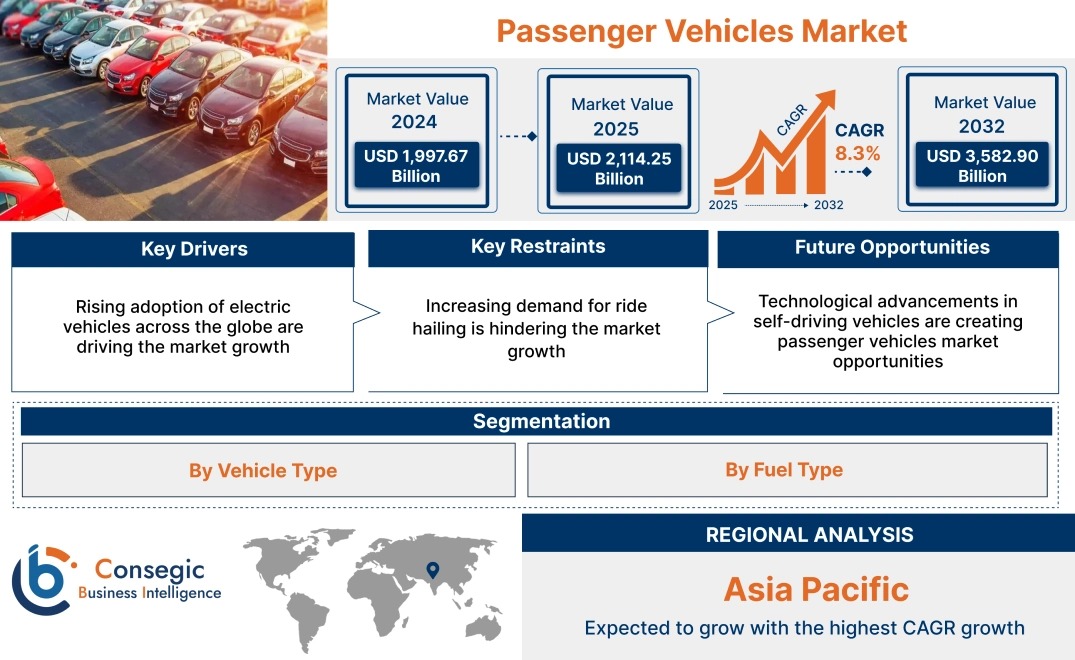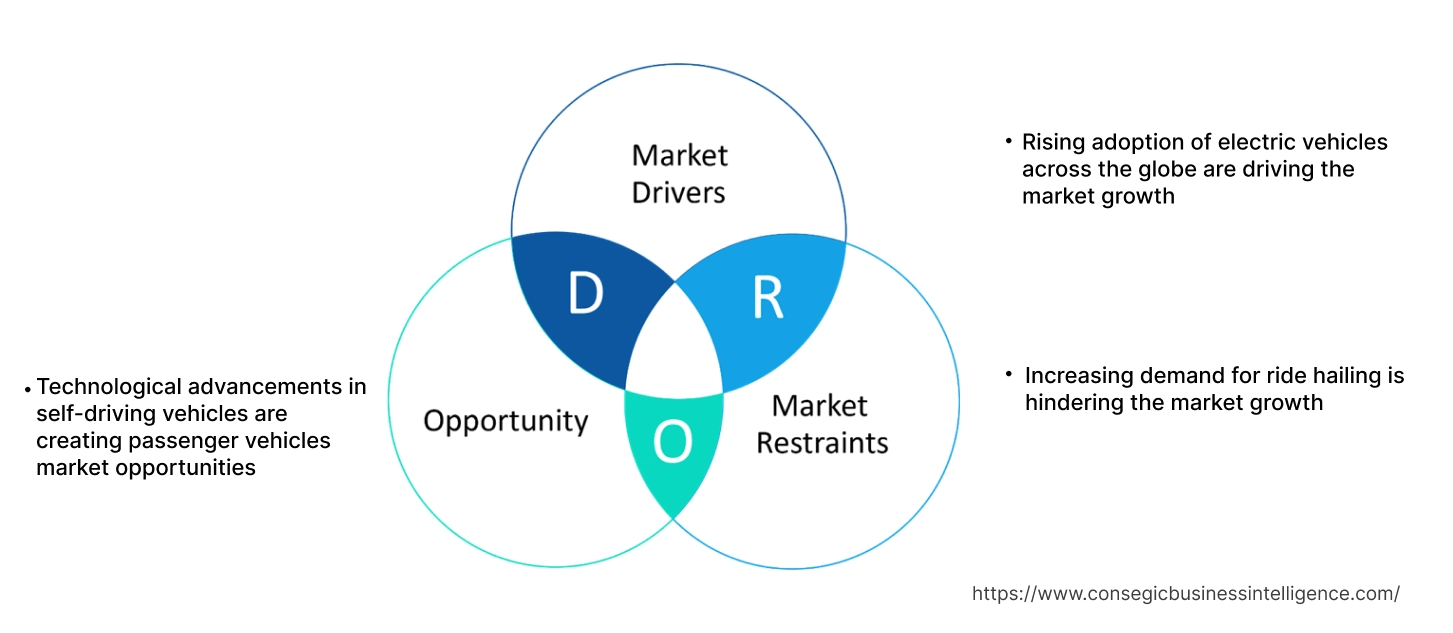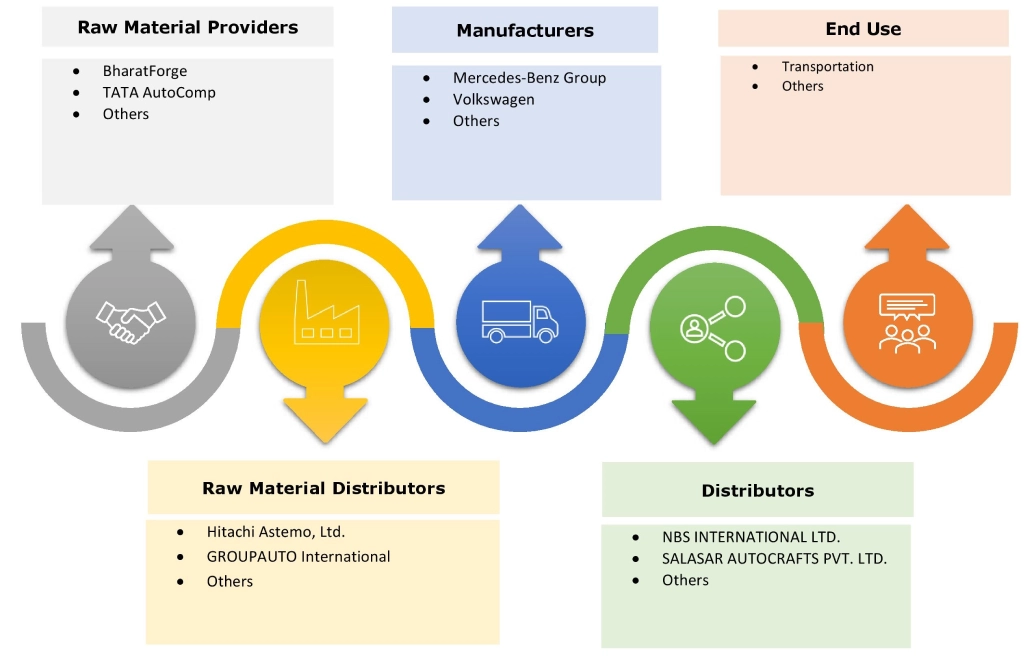- Summary
- Table Of Content
- Methodology
Passenger Vehicles Market Size:
Passenger Vehicles Market size is estimated to reach over USD 3,582.90 Billion by 2032 from a value of USD 1,997.67 Billion in 2024 and is projected to grow by USD 2,114.25 Billion in 2025, growing at a CAGR of 8.3% from 2025 to 2032.
Passenger Vehicles Market Scope & Overview:
Passenger vehicles are incorporated with at least two axes and a seating capacity of not more than 8 people including the driver. Also, the items loaded on a passenger vehicle should not be weighted more than 3.5 tons. Moreover, passenger vehicles are mostly used for passenger transportation for facilitating public road transport. Furthermore, vehicle registration and driver’s license are required to drive these vehicles on public roads. These vehicles are available in types including SUV, sedans, vans, MPV, and hatchback.
Key Drivers:
Rising adoption of electric vehicles across the globe are driving the market growth
Electric vehicles sales are booming worldwide due to the factors including low running costs, government subsidies, low environmental impact, low maintenance costs, low registration and road tax among others. Moreover, the expanding charging infrastructure, technological advancements, and rising investments in the industry are further boosting the sales of electric vehicles.
- For instance, according to International Energy Agency (IEA), the electric car sales were 3.5 million units higher in 2023 than that of 2022. Moreover, in 2023, electric car vehicles accounted for 18% of all cars sold.
Thus, the aforementioned factors are boosting the electric car sales, in turn, driving the passenger vehicles market growth.
Key Restraints:
High initial costs and maintenance are restraining the Passenger Vehicles Market growth
Ride haling or ride sharing offers users a cost-effective, affordable, convenient, and accessible, and efficient solution. Ride sharing reduces the traffic congestion, emissions, pressure on parking infrastructure, and costs among others. Moreover, these solutions are time saving and offer 24/7 hours availability in most of the areas.
Furthermore, ride sharing solutions also create employment for people, promoting their usage in urban areas, in turn, boosting the ride sharing platforms usage. Thus, the passenger vehicles market analysis shows that the aforementioned factors are restraining the passenger vehicles market demand.
Future Opportunities :
Technological advancements in self-driving vehicles are creating passenger vehicles market opportunities
Self-driving or automated cars use ADAS (Advanced Driver Assistance Systems), sensors, machine learning algorithms, and other technologies to drive the vehicle without human assistance. Advanced sensors, mapping technology, AI algorithms altogether form a system to take informed, real-time, and quick decisions, based on the environment. Moreover, automated vehicles are able to share real-time information about traffic, weather conditions, and others.
- For instance, in March 2025, Wayve launched an on-road testing and development hub in Germany. This expansion is expected to advance AI-driven automated driving systems in the diverse and demanding environment of Germany.
Thus, market analysis concludes that the ongoing advancements in the self-driving cars are projected to drive passenger vehicles market opportunities during the forecast period.
Passenger Vehicles Market Segmental Analysis :
By Vehicle Type:
Based on the vehicle type, the market is segmented into SUV, Sedan, Hatchback, and MPV.
Trends in the Vehicle Type:
- Rising trend in adoption of MPV (Multipurpose vehicles) due to factors including multiple seating row, spacious interiors, large cargo capacity, and others.
- Increasing demand in sedans for comfortable and fuel-efficient rides is boosting the passenger vehicles market size.
The SUV segment accounted for the largest revenue share of 39.27% in the passenger vehicles market share in 2024 and it is also expected to register the fastest CAGR during the forecast period.
- SUV (Sports Utility Vehicle) provides excellent exterior and interior design, enhanced driving experience, advanced features, safety, and aesthetics.
- Moreover, the larger seating capacity and the ability to drive efficiently on rough terrain is driving the shift towards SUV segment.
- For instance, in January 2025, XPENG’s G6 electric SUV launched in UK. This SUV is available in two models, one with 285PS motor and 87.5kWh battery and other with 258Ps motor and 66kWh battery.
- Therefore, the market analysis shows that the rising trend in adoption of SUV in the global market is boosting the passenger vehicles market trends.
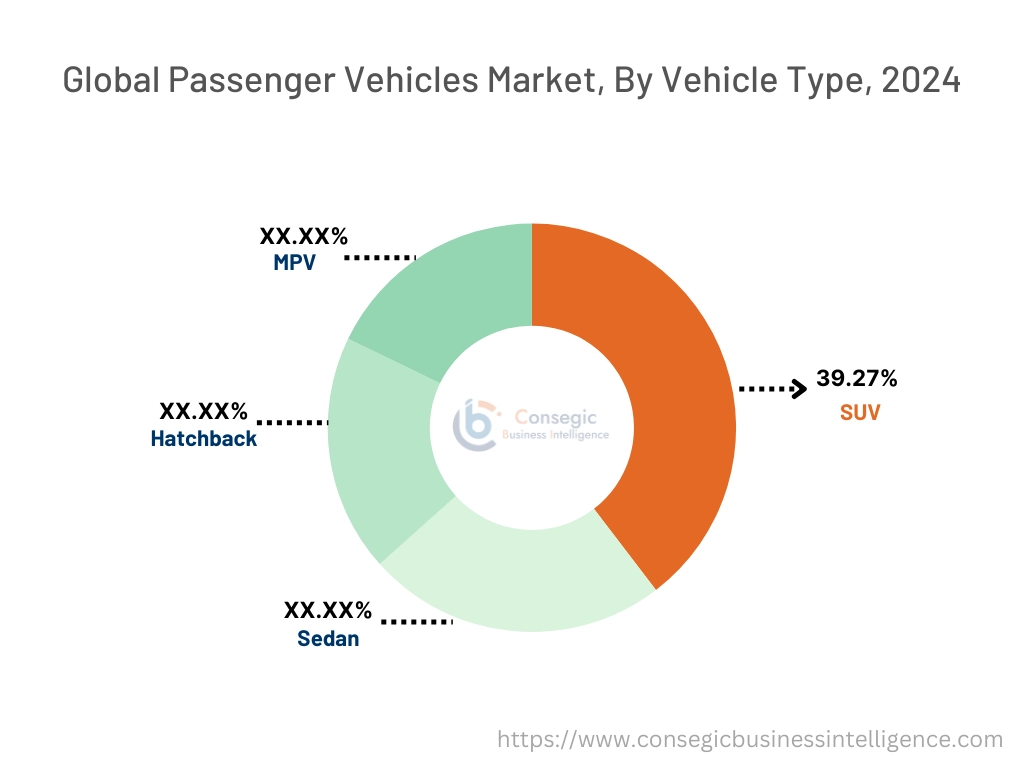
By Fuel Type:
Based on the fuel type, the market is segmented into petrol, diesel, hybrid, electric, and CNG.
Trends in the Fuel Type:
- Rising trends in adoption of hybrid vehicles due to lower running costs, emissions, and improved fuel economy.
- Increasing demand and adoption of CNG vehicles due to factors including lower maintenance costs and longer engine life is boosting the passenger vehicles market size.
The petrol segment accounted for the largest revenue share in the passenger vehicles market share in 2024.
- The petrol vehicles are widely penetrated worldwide due to wider availability of models, better handling, lower initial purchase costs, easy refueling, and others.
- For instance, in July 2024, Honda Freed compact MPV was launched in Japan. It is available in two models including a 1.5L petrol engine with an e:HEV dual-motor system and 1.5L NA petrol engine.
- Therefore, the market analysis depicts that the widespread adoption of petrol vehicles is boosting the passenger vehicles market trends.
The electric segment is expected to register the fastest CAGR during the forecast period.
- Electric vehicles are efficient and cost effective due to factors including lowered emission rates, reduced carbon footprint, reduced fuel costs, lowered maintenance costs, and reduced noise pollution, among others.
- For instance, in October 2024, Toyota Motor Co. and Suzuki Motor Corp. announced their collaboration on a new electric SUV. This new model is expected to be manufactured at Suzuki Motor Gujarat in India.
- Thus, the rising trends in adoption of electric vehicles due to their benefits and advantages is expected to boost the passenger vehicles market expansion during the forecast period.
Regional Analysis:
The regions covered are North America, Europe, Asia Pacific, the Middle East and Africa, and Latin America.
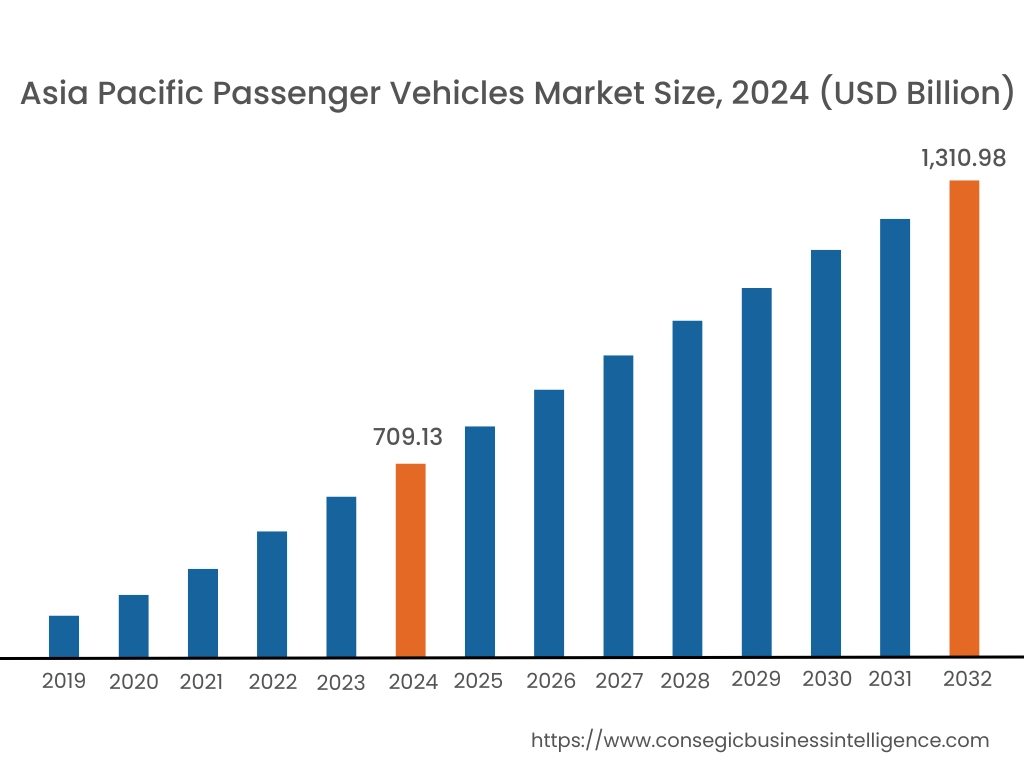
Asia Pacific region was valued at USD 709.13 Billion in 2024. Moreover, it is projected to grow by USD 752.43 Billion in 2025 and reach over USD 1,310.98 Billion by 2032. Out of this, China accounted for the maximum revenue share of 37.91%. In Asia, brands including Toyota and nHyundai lead the passenger vehicles market growth with strong sales in Japan, South Korea, and Southeast Asia. Moreover, the market is primarily driven by consumer preferences, disposable income, infrastructural development, and rising living standard.
- For instance, according to Hyundai’s analysis, in FY 2023, the total passenger vehicles sold in India reached 3.9 million units, among which SUV contributed for 44.0% of total sold units. The above factors are driving the passenger vehicles market in the Asia-Pacific region.

North America is estimated to reach over USD 983.15 Billion by 2032 from a value of USD 563.94 Billion in 2024 and is projected to grow by USD 595.46 Billion in 2025. The market in the region is driven by consumer preferences for fuel efficiency and environment-friendly and sustainable vehicles.
- For instance, according to European Automobile Manufacturers’ Association (ACEA), North America produced 11.4 million cars in 2024. While the global car manufacturing was 75.5 million units.
As per the passenger vehicles market analysis, in Europe, the market is growing due to rise in disposable income, and initiatives of sustainable mobility in the region, leading to growth of passenger vehicles market demand. In Middle East and Africa and Latin America, the market growth is driven due to greater affordability of vehicles, enhanced domestic vehicle production, EV infrastructure development, and others, in turn, proliferating the passenger vehicles market expansion.
Top Key Players and Market Share Insights:
The passenger vehicles industry is highly competitive with major players providing products to the national and international markets. Key players are adopting several strategies in research and development (R&D), product innovation, and end-user launches to hold a strong position in the global passenger vehicles market. Key players in the passenger vehicles industry include -
- Mercedes-Benz Group (Germany)
- Volkswagen (Germany)
- Maruti Suzuki India Limited (India)
- Mahindra Auto (India)
- Tata Motors (India)
- Force Motors (India)
- Ford Motor Company (US)
- PEUGEOT (France)
- Renault (France)
- SEAT (Spain)
Recent Industry Developments :
Product Launches:
- In February 2025, FAW’s Hongqi launched an electric sedan Tiangong 05 in China. The car is available with 18-inch wheels and dimensions 4820/1915/1480 mm with a wheelbase of 2900 mm.
Passenger Vehicles Market Report Insights :
| Report Attributes | Report Details |
| Study Timeline | 2019-2032 |
| Market Size in 2032 | USD 3,582.90 Billion |
| CAGR (2025-2032) | 8.3% |
| By Vehicle Type |
|
| By Fuel Type |
|
| By Region |
|
| Key Players |
|
| North America | U.S. Canada Mexico |
| Europe | U.K. Germany France Spain Italy Russia Benelux Rest of Europe |
| APAC | China South Korea Japan India Australia ASEAN Rest of Asia-Pacific |
| Middle East and Africa | GCC Turkey South Africa Rest of MEA |
| LATAM | Brazil Argentina Chile Rest of LATAM |
| Report Coverage |
|
Key Questions Answered in the Report
How big is the passenger vehicles market? +
Passenger Vehicles Market size is estimated to reach over USD 3,582.90 Billion by 2032 from a value of USD 1,997.67 Billion in 2024 and is projected to grow by USD 2,114.25 Billion in 2025, growing at a CAGR of 8.3% from 2025 to 2032.
What are the major segments covered in the passenger vehicles market report? +
The segments covered in the report are vehicle type, fuel type, and region.
Which region holds the largest revenue share in 2024 in the passenger vehicles market? +
Asia Pacific holds the largest revenue share in the passenger vehicles market in 2024.
Who are the major key players in the passenger vehicles market? +
The major key players in the market are Mercedes-Benz Group (Germany), Volkswagen (Germany), Maruti Suzuki India Limited (India), Mahindra Auto (India), Tata Motors (India), Force Motors (India), Ford Motor Company (US), PEUGEOT (France), Renault (France), and SEAT (Spain).
